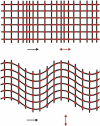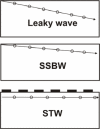Surface generated acoustic wave biosensors for the detection of pathogens: a review
- PMID: 22346725
- PMCID: PMC3274150
- DOI: 10.3390/s90705740
Surface generated acoustic wave biosensors for the detection of pathogens: a review
Abstract
This review presents a deep insight into the Surface Generated Acoustic Wave (SGAW) technology for biosensing applications, based on more than 40 years of technological and scientific developments. In the last 20 years, SGAWs have been attracting the attention of the biochemical scientific community, due to the fact that some of these devices - Shear Horizontal Surface Acoustic Wave (SH-SAW), Surface Transverse Wave (STW), Love Wave (LW), Flexural Plate Wave (FPW), Shear Horizontal Acoustic Plate Mode (SH-APM) and Layered Guided Acoustic Plate Mode (LG-APM) - have demonstrated a high sensitivity in the detection of biorelevant molecules in liquid media. In addition, complementary efforts to improve the sensing films have been done during these years. All these developments have been made with the aim of achieving, in a future, a highly sensitive, low cost, small size, multi-channel, portable, reliable and commercially established SGAW biosensor. A setup with these features could significantly contribute to future developments in the health, food and environmental industries. The second purpose of this work is to describe the state-of-the-art of SGAW biosensors for the detection of pathogens, being this topic an issue of extremely importance for the human health. Finally, the review discuses the commercial availability, trends and future challenges of the SGAW biosensors for such applications.
Keywords: Acoustic Plate Modes (APM); Love Wave; Surface Acoustic Wave (SAW); biosensors; pathogen agents.
Figures


















References
-
- Leonard P., Hearty S., Brennan J., Dunne L., Quinn J., Chakraborty T., O'Kennedy R. Advances in biosensors for detection of pathogens in food and water. Enzyme Microb. Technol. 2003;32:3–13.
-
- Ivnitski D., Abdel-Hamid I., Atanasov P., Wilkins E. Biosensors for the detection of pathogenic bacteria. Biosens. Bioelectron. 1999;14:599–624. - PubMed
-
- Anon Waterborne pathogens kill 10M–20M people/year. World Water Environ. Eng. 1996 Jun 6;
-
- Montoya A., Ocampo A., March C. Fundamentals of piezoelectric immunosensors. In: Arnau A, editor. Piezoelectric Transducers and Applications. 2nd ed. Springer; Berlin Heidelberg: 2008. pp. 289–306.
-
- Rickert J., Göpel W., Hayward G.L., Cavic B.A., Thompson M. Biosensors based on acoustic wave devices. Sens. Update. 2001;5:105–139.
LinkOut - more resources
Full Text Sources
Other Literature Sources

